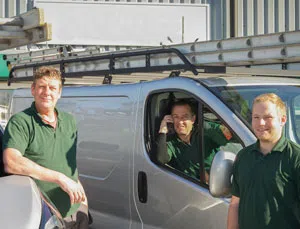Time spent mentoring and bonding with your employees in the field is solid gold.
Finding the time to escape from the office and ride with one of your technicians for a day can be difficult. Most owners and managers agree this is something they should be doing, but it’s also something that tends to be pushed down the priority rung of the ladder as they react to more urgent matters.
This is the world we live in, right? There’s always a customer to talk to, an interview to conduct or an employee who needs some attention. Those are all important, of course, but those are reactive activities. you’re reacting to the situation at hand instead of following a process.
Most of the time these activities fall on the person wearing the service manager hat. This is one of the most demanding roles within the company, and a lot of the fires tend to land on their plate. The fires probably won’t go away, but here are some best practices for getting your ride-along process off the ground.
Start with a Plan
Be realistic about the time you can devote to getting into the field. Every business is different and the responsibilities of the people doing the ride-alongs are also different. Devoting two days a week to the process would be great, but if all you can commit to is an afternoon per week, it’s a start.
The critical action is to follow the plan and take the actions that will free up your time on the ride-along days. This involves designating who will cover your daily activities when you’re out in the field. Your coworkers will typically agree the ride-alongs are important and are willing to support the process, because having better training results in the field makes everyone’s job easier in the long run.
Block out your schedule on ride-along days, so you can focus on the task at hand without distractions. A monthly schedule works best.
Next, determine who you will ride with on those days you have blocked out. Everyone should be on the ride along schedule, but it doesn’t mean everyone gets equal time. Some technicians may need a little more training than others. Don’t ignore your top producers or long-term employees.
Aside from the developmental opportunities involved in a ride-along, you may discover there is an important cultural benefit of riding with your technicians. You’ll get to know them better and it’s a great opportunity to learn how you can improve things of which you may not have been aware.
Underperforming technicians or green technicians often feel you’re riding with them because they aren’t doing well. When they see that everybody is on the schedule, it takes that cloud away.
When your ride-along schedule is consistent and that cloud of negativity goes away, the results will continue to improve. Trust goes up.
Post the Schedule
Ride-alongs aren’t meant to be a surprise inspection. You want your technicians to have every opportunity to shine. Catch them at their best, not at their worst. You’re looking for opportunities to praise, because that’s more effective than scolding.
You want to see their truck clean, appearance tight and best foot forward. Review the schedule a few days prior to the ride and work with the dispatcher to craft the type of day you want to observe. It’s better to be proactive in this experience than reactive.
If the technician you lined out for a ride is going to be on an all-day dig or install, then there is no reason to go out with them and the opportunity is lost. You can adjust to the next scheduled person on the schedule. This is going to happen, but you can reduce that by being involved earlier in the process.
By looking at the dispatch board the days before your scheduled ride, you can give the next-in-line technician a heads-up that you will be riding with them. Waiting until the morning of isn’t the best process.
Ride-Along
Getting in the technician’s van and physically riding with them when possible is the best practice. This windshield time gives you the most quality time with your technician. Getting to know the technician better and letting them get to know you builds better communication.
There are also a number of important things you can learn about your technician when riding with them. Evaluating their driving ability is relevant, as is adherence to other company standards and policies. You’re not looking for opportunities to “bust” them. You’re looking for training opportunities or opportunities for improvement.
Is there a problem with your processes? Are your technicians getting their parts restocked in a timely manner? Do they have the tools they need? Do they need more training?
Ride-alongs are a real eye opener. There may be times where the traditional ride with the technician to and from the shop may not make sense. The goal is to get as much windshield time as possible with your technician, but if traffic is going to make his drop off a three-hour journey, then that becomes a negative. Driving to a designated area and then getting in the truck may make more sense.
While riding with your technicians, be clear on your expectations. Don’t assume they understand what you’re looking to see. If you’re expecting them to follow a specific process that you have trained on and they don’t know that, confusion is the result.
It’s critical the person doing the ride-along not only communicates the expectation but models the expectation. Your processes should be held high. If you do not set the standards when you’re with your technicians, then they certainly will not be followed when you’re not.
When riding, you should be the second technician. If the customer knows you’re the boss, the whole dynamic changes.
The customer will start directing their questions to you instead of the primary technician and you’ll lose the ability to be the observer. There may be times
when you become the performer, but this should be discussed and agreed upon prior to the call.
You spend a lot of time, energy and money training your technicians. If the rest of your processes are seemingly tight, you’ll not know what is going on unless you do ride-alongs.
This is where the rubber meets the road at the fundamental level. This is where you see if the training is sticking and being applied or if you need to correct your approach.
The time you spend mentoring and bonding with your employees in the field is solid gold. There is a natural connection when you buy lunch or a coffee and discuss the day.
Being in the attic or under the house and helping your technician craft their customer options is a high-return activity. When they see you suit up and work with them, it often changes their perception of you.
Remember to document the ride-along and set actionable items to follow up with on your next ride. By keeping a ride-along log, you won’t forget the action items to which you agreed.
Failing to follow up on an action item is like a teacher not correcting your homework, so don’t miss an opportunity to praise.
By developing your technicians in the field through a consistent ride-along process, you’ll measure noticeable improvement in your key performance indicators, customer satisfaction and employee engagement. Have fun and lead from the front.






